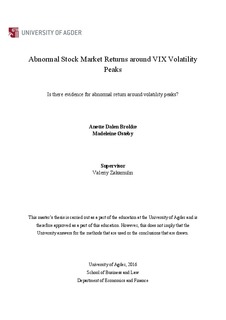| dc.description.abstract | Is has been observed that the volatility index, VIX, often ends in a spike peak. The intention
when introducing VIX was to measure the volatility related to S&P indices. Evidence in the
literature argue that VIX is an estimate of investors sentiment and fear, by need for insurance
of portfolio in term of options. In the thesis we outlined three studies related to VIX and S&P
500. We perform a replica study of the already observed asymmetrical relation between VIX
and S&P 500, where we include symmetrical models to discuss the results. Furthermore, two
studies take the spike peak in VIX into account. The first determine the peaks of VIX in terms
of rising and falling phases and contains statistical summary of the phases. The second study
determine the abnormal return in S&P 500 around the peaks in VIX, with use of a window
including ten days before peak and ten days after peak. The studies are motivated by the
relationship between the VIX and S&P 500. There are limited literature about VIX in terms of
phases of rising and falling volatility. The motivation for these studies is to find a clear structure
of the relationship around the spike peak. To understand investors sentiment, theory from the
literature about behavioral finance are included. The research goals for the studies are to find
clear patterns of how return act in relation to volatility. We expect evidence of negative
relationship between VIX and S&P 500, where S&P 500 increases more slowly then it drops.
In terms of the abnormal returns we expect the return to be significantly negative before the
peak and significantly positive in the days after the peak. The results from the replica study give
evidence of a negative relationship, although we did not reach all the expected results as in
Whaley (2000) and Whaley (2009). Results for the study of peaks shows that duration of a
falling phase is longer than duration of a rising phase, and the opposite for amplitude in VIX.
Results for the abnormal study show a clear negative trend of abnormal return before the peak,
cumulative abnormal return of – 4.106 percent for the eleven first days of the event study. In
addition, the abnormal return for the ten days after the peak gave 3.12 percent. | nb_NO |
